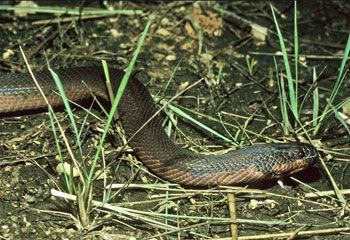
E: Environment, Enrichment,
Education, & Endangered Species
All content © by Diana L. Guerrero unless otherwise noted and may not be reprinted without prior written permission. All rights reserved. Click here for reprint permissions and fees.
A “chameleon snake” known as the Kapuas mud snake (Enhydris gyii) was recently discovered in Kalimantan area of the Borneo rainforest. The unusual reptile was discovered by Dr. Mark Auliya near the Kapuas river located in the Betung Kerihun National Park in Kalimantan (Indonesian Borneo). The discovery of our animal of the month was officially announced in June of 2006. Left: Kapuas Mud Snake found in Kalimantan, Borneo. Photo by Dr. Mark Auilya courtesy of WWF.
Animal of the Month
Kapuas Mud Snake (Enhudris gyii)
A new snake has been discovered in Kalimantan area of the Borneo rainforest. The color changing snake, called the Kapuas mud snake (Enhydris gyii), lives in a fragile ecosystem threatened by human influences such as logging and agricultural development.
Currently nicknamed the "chameleon snake," the unusual reptile was discovered by Dr. Mark Auliya, a reptile expert at the Zoologisches Forschungsmuseum Alexander. The scientific team obtained two specimens of the forest dwelling poisonous snake near the Kapuas river located in the Betung Kerihun National Park in Kalimantan (Indonesian Borneo).
When caught, the reptile was a reddish brown but when Dr. Auliya went back to retrieve the animal it had turned white. There are lizards who change color to match their surroundings, or to express mood, but few snakes are known to have that ability.
The Kapuas mud snake is one of the few snakes known to have color-changing ability. It is currently unknown how the Kapuas mud snake (Enhydris gyii) changes color. Some chameleons (lizards) change colors by using specialized cell layers beneath a transparent outer skin. The upper layer produces the yellow and red hues while the other layer reflects blue light.
Stuart Chapman serves as the international coordinator of the Heart of Borneo initiative for the World Wildlife Fund, a leading conservation group that has been concerned about the Bornean forest rapid decline since the 1980s. He believes the discovery of this new reptile is important for conservation efforts in Borneo. The area is unique and an estimated 361 new species of animals have been discovered between 1994 and 2004.
The World Wildlife Fund is working with the governments of Brunei Darussalam, Indonesia and Malaysia to help ensure that these unique ecosystems are protected in the future.
About the columnist: Since 1978 Diana L. Guerrero has worked professionally with both wild and domestic animals. Guerrero has been affiliated with, and certified by, a variety of animal programs in the USA and Europe. Based in California, she writes, consults, and speaks. Information on her animal career programs, training courses, and her books {What Animals Can Teach Us about Spirituality (SkyLight Paths, 2003), Blessing of the Animals (Sterling, 2007), Help! My Pet is Driving Me Crazy (Guerrero Ink, 2007), Animal Disaster Preparedness for Pet Owners & Pet Professionals (Guerrero Ink, 2007)} can be found in this web site and in the shop. Questions for Guerrero should be submitted via the blog comments or membership forum.





